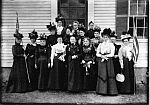 (HOST) All this week on Morning Edition, VPR is honoring women who have contributed to the life and culture of Vermont. Today, Christine Smith – history teacher at Spaulding High School and Barre Technical Center – has the story of the Women’s Relief Corp in post-Civil-War Vermont.
(HOST) All this week on Morning Edition, VPR is honoring women who have contributed to the life and culture of Vermont. Today, Christine Smith – history teacher at Spaulding High School and Barre Technical Center – has the story of the Women’s Relief Corp in post-Civil-War Vermont.
(SMITH) The year was 1892, and Calista Jones of Bradford was on the way home from a visit to Washington DC when she stopped at Gettysburg. Later she recalled,
"When we came to the Vermont State monument, which is crowned with a statute of Gen. Stannard, I placed on its base a bouquet of flowers… thus honoring the man who bore the proud distinction of being the first Vermonter to volunteer after the firing upon Fort Sumter in 1860. A little further on, at High Water Mark, I was forcibly impressed with what our Vermont troops did; for they were right there where the great battle was decided, and helped to make it a victory – the turning point of the Civil War."
Women were denied membership into the Grand Army of the Republic, a national fraternity of Civil War veterans. However, in 1883 a women’s auxiliary to the GAR – the national Women’s Relief Corp or WRC – was born. A Vermont Corp was started in 1885, and Mina G. Hooker of Brattleboro, wife of famed VT Civil War veteran and GAR Commander George W. Hooker, became their first president. By 1892, the membership of two hundred had grown to more than two thousand. Our Gettysburg visitor Calista Jones of Bradford, became the 19th president of the National WRC in 1902.
The WRC undertook projects that ranged from financial relief to the creation and maintenance of the Soldiers Home in Bennington and a national home to accommodate army nurses, veterans, and dependent relatives.
Through their "Patriotism in the Public Schools campaign", the WRC of Vermont promoted putting into every classroom: "a Declaration of Independence Chart and Patriotic Primer", the Pledge of Allegiance, and a flag with a manual on how to salute it properly. They also urged the "observance of all patriotic anniversaries".
Women would not gain the right to vote until 1920, but the WRC gave them a voice with which to express their patriotism.
Perhaps their most lasting achievement was promoting a beautiful and symbolic spring ritual to "perpetuate the memory of their heroic dead" with prayer, parades, music, speeches, and floral decoration of the graves of the fallen. We know it as Memorial Day, and by 1888, May 30th had become a national day of mourning.
Children were considered "custodians of their fathers’ valor" and in 1889, women in Barre boasted that more than 300 children took part in their celebration. By 1894, Manchester Depot reported more than 450 children participating in their parade.
The scent of lilacs always reminds me of walking with my classmates from the Beeman Elementary School in New Haven to the Evergreen Cemetery about a mile away, where we placed little floral bundles on the flag-decorated graves – a gesture directly descended from the efforts of the Vermont Women’s Relief Corps.
This year on Memorial Day, I hope we remember not only the veterans, but also the thousands of women who worked to ensure that remembrance.